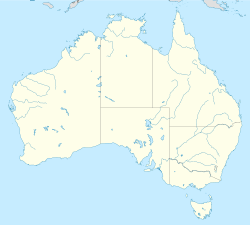Cuddie Springs facts for kids
| Location | Carinda, Walgett Shire, New South Wales, Australia |
|---|---|
| Coordinates | 30°47′13″S 147°28′41″E / 30.78694°S 147.47806°E |
| Length | 200 m (660 ft) |
| Width | 200 m (660 ft) |
| History | |
| Periods | Pleistocene |
| Cultures | Prehistoric Australia |
| Site notes | |
| Excavation dates | 1933, 1991–2009 |
| Archaeologists | Judith Field Richard Fullagar |
Cuddie Springs is a really important place in central northern New South Wales, Australia. It's special for both archaeology (studying human history) and paleontology (studying ancient life). You can find it near a town called Carinda.
This site is an open area where fossils are kept safe in a claypan. A claypan is like a shallow basin that fills with water after it rains. The water can stay there for months, which helped protect the fossils over a very long time.
Cuddie Springs is famous because it was the first place where scientists clearly found stone tools alongside the bones of huge, ancient animals called Australian megafauna. These animals were much bigger than today's animals. People have known about fossils here since the late 1870s. Major digs happened in 1933 and then again from 1991 to 2009.
Contents
What's in a Name?
The name 'Cuddie' comes from the language of the local Aboriginal people. It means "bad." This might refer to the water in the Cuddie lake, which is a bit salty or alkaline. Even though it's called 'Cuddie Springs,' it's actually a lake that dries up sometimes, not a natural spring.
Digging Up the Past
Both Aboriginal people and early European settlers knew Cuddie Springs was a place with ancient bones. Aboriginal Dreamtime stories tell about how the bones got there.
Europeans started living in the area around the 1830s. In 1876, a well was dug in the middle of the claypan. Workers found large fossil bones and sent them to the Australian Museum. These bones were from giant animals like Diprotodon (a huge wombat-like animal), Genyornis (a giant bird), and Megalania (a giant lizard).
The first big scientific dig at Cuddie Springs happened in 1933. Researchers dug many trenches and pits. They found lots of animal bones, but they didn't find any human tools or signs of human activity at that time.
Later, in 1991, new excavations began. Scientists were looking for ancient pollen but found many bones and a thick layer of flaked stone tools. This showed that the site was important for both ancient animals and human history. The main archaeological digs continued from 1996 to 2009. Most of the things found are now kept at the Australian Museum.
The Ancient Environment
Cuddie Springs is in a dry area today. But studies of ancient pollen show that about 40,000 years ago, it was a large, permanent lake. This lake was surrounded by open shrub land, which was a perfect home for the giant megafauna.
Humans and Megafauna: Did They Live Together?
One of the biggest questions about Cuddie Springs is whether humans lived alongside the megafauna for a long time. Some scientists believe that humans and megafauna lived together at Cuddie Springs for about 10,000 years. If this is true, it would suggest that climate change, not humans, was the main reason these giant animals died out. They argue that megafauna started disappearing long before humans arrived in some places. Also, their large size made them sensitive to changes in their environment.
However, other scientists have looked closely at the evidence from Cuddie Springs. They point out some things that make them wonder if the human tools and megafauna bones really belong together in the same time period.
- Some finds, like grinding stones, are usually found in much more recent times in Australia.
- A crocodile tooth found in the megafauna layers is from a type of crocodile that died out much earlier.
- Some stone tools have traces of hair and blood, but nearby megafauna bones have no protein left. This suggests they might not be from the same time.
These differences make some scientists think that the layers at Cuddie Springs might have gotten mixed up over time. This could happen because of water moving underground or through past digging by people. For example, a well was dug in 1876, and trenches were dug in 1933. Even cattle visiting the well might have pushed things around.
Scientists are still studying Cuddie Springs to understand exactly how the layers formed and if the human tools and megafauna bones were truly deposited at the same time. It's a unique site that helps us learn more about the mystery of why Australia's giant animals disappeared.
See also
 In Spanish: Cuddie Springs para niños
In Spanish: Cuddie Springs para niños


